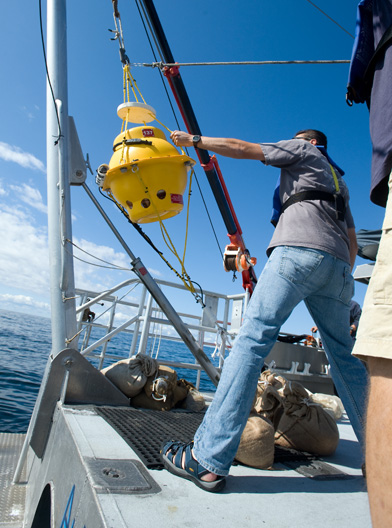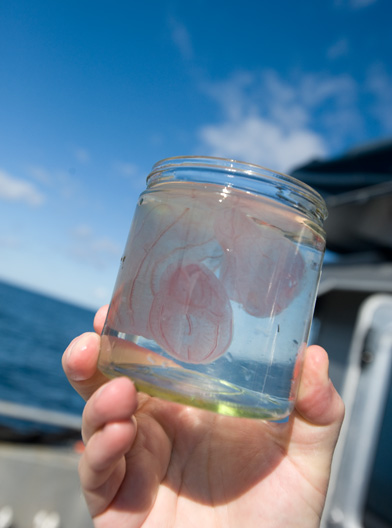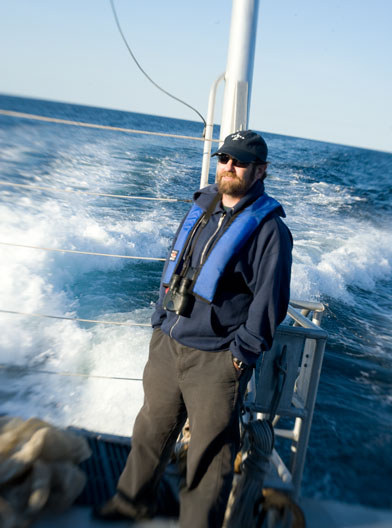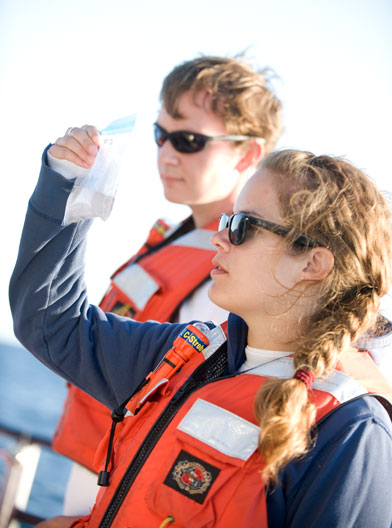 Mike Thompson, a graphic image specialist for the Stellwagen Bank National Marine Sanctuary, prepares to lower an underwater microphone that records movements of fish tagged by BU researchers. Photos by Vernon Doucette.
Mike Thompson, a graphic image specialist for the Stellwagen Bank National Marine Sanctuary, prepares to lower an underwater microphone that records movements of fish tagged by BU researchers. Photos by Vernon Doucette.
By midafternoon, the summer sky that emerged pale blue over Scituate Harbor is weighed down with gray, coal-rimmed clouds. The wind carries the smell of low tide and the clanging of moorings securing the yachts and powerboats of the wealthier citizens of this coastal Massachusetts town. But this is a working harbor, too, and over at the pier, Frank Mirarchi is mending a net at the stern of his fifty-five-foot fishing trawler, the Barbara L. Peters.
For nearly half a century, Mirarchi has been pulling cod, haddock, and flounder out of the Gulf of Maine, which stretches from the tip of Cape Cod to Nova Scotia. But he’s worried that his son Andrew, who works the trawler with him, won’t have anywhere near that kind of longevity at sea.
“We’re hanging on by the skin of our teeth,” says Mirarchi, a stocky man in his sixties wearing grubby olive pants and a white T-shirt. To Mirarchi, and to many fishermen like him, the reason is simple: New England fishermen are being regulated to death. The restrictions on when, where, and how they can work began piling up in the mid 1990s, when overfishing had reduced many stocks to critically low levels, and the government set species-by-species recovery targets. The results of those recovery programs are mixed at best. But for fisherman, and potentially for the region’s maritime heritage, the status quo may threaten disaster.
Now, a growing group of scientists is urging a new approach, one that moves away from blanket restrictions and the focus on individual fish and whale species in favor of a system tailored to an understanding of how marine ecosystems work. One of the leading proponents of the idea, known as area management, is Les Kaufman, a College of Arts & Sciences professor of biology and associate director of the Boston University Marine Program (BUMP). For years, Kaufman has studied the ecosystems of Stellwagen Bank National Marine Sanctuary, an area in the Gulf of Maine the size of Rhode Island, whose rich biodiversity is a magnet for commercial fisherman, recreational anglers, and whale watchers. His research helped shape the draft of a five-year management plan for Stellwagen issued in April by the Office of National Marine Sanctuaries, part of the National Oceanic and Atmospheric Administration (NOAA). The first two thirds of the document, which will be revised into final form sometime next year, is an ecological audit that paints a grim picture of the sanctuary’s health and argues for the principle of ecology-based restoration that Kaufman endorses.
The draft is the result of a lengthy consensus-based process involving scientists, fishermen, industry and environmental groups, and about 20,000 citizen comments. Naturally, it satisfies almost no one. Fishermen and other commercial users feel unjustly blamed for the degraded state of the sanctuary and fear that the findings may be used to drive them out of business. Meanwhile, although the plan embraces the ecosystem-based management approach that Kaufman’s science supports, it proposes almost no concrete actions, leading Kaufman and many environmentalists to disparage it as toothless. Hovering over all is the question of whether the other government agencies that oversee most human activities on Stellwagen and the Gulf of Maine will back a switch to ecosystem conservation. If they do, Stellwagen Bank could be a major test case for a new approach to restoring the health of the sea and the livelihoods, such as Frank Mirarchi's, that depend on it.
 Videos by Devin Hahn
Videos by Devin Hahn
This three-part video series explores how science is shaping a new approach to protecting the health of the oceans and the fishing industry.
1. Watch part 1
2. Watch part 2
3. Watch part 3
Get the Flash Player to see this media.
 A specimen of Beroe cucumis, a comb jelly that abounds in these waters in late summer. BU students caught the jellies and will use them to study Stellwagen’s food web.
A specimen of Beroe cucumis, a comb jelly that abounds in these waters in late summer. BU students caught the jellies and will use them to study Stellwagen’s food web.
Stellwagen Bank sits about twenty-five miles east of Boston. Before the last ice age ended, about 11,000 years ago, Stellwagen was above water and connected to the mainland, a dry, cold expanse marked by beaches, lagoons, and seaside cliffs, probably covered with spruce forests and tundra grasses. When the glaciers retreated and Stellwagen disappeared beneath the sea, its diverse topography and mix of sand, mud, and rocky habitats gave rise to an unusual level of oceanic biodiversity. Today, the 842-square-mile Stellwagen sanctuary is home to more than eighty species of fish, thirty-four types of birds, and twenty-two marine mammals, several endangered whales among them.
In 1992, the U.S. Congress placed Stellwagen under the protection of the National Marine Sanctuaries, which consists of thirteen marine sanctuaries. The Stellwagen sanctuary, whose agents occupy a white-shingled building at Scituate Harbor, is home also to the NOAA research vessel Auk, a fifty-foot aluminum catamaran. And when the Auk heads out to tag whales, test water quality, or track fish with underwater cameras, it is rarely alone. The same lush environment that lures marine life attracts humans — lots of them, from commercial fishermen to whale watchers to divers checking out historic shipwrecks.
Between 1996 and 2005, commercial fishermen harvested an average annual catch worth nearly $16 million. Meanwhile, a growing whale-watch industry generates about $24 million annually in Massachusetts alone.
“If you go out there in the summer, there are boats everywhere,” says Rick Murray, a CAS professor of earth sciences and the director of the BU Marine Program, who is one of five Scituate selectmen. “It’s an amazing confluence of civilization and natural habitats.”
But, Kaufman notes, this level of usage has its price, with challenges ranging from habitat preservation to the status of key species to the area’s biodiversity. For instance, NOAA’s 2008 assessment of the nineteen fish stocks it began trying to rebuild in the 1990s found that thirteen had still not made it halfway to the target numbers — the same as in 2002 and 2005. In addition, between 2005 and 2008 the number of stocks being overfished jumped from eight to thirteen. Meanwhile, the annual revenues of New England fishermen who pursue these stocks fell by half between 2000 and 2007.
“We’d grade it a C minus,” says Craig McDonald, the sanctuary’s superintendent, “and you shouldn’t have an area designated by Congress as one of the nation’s marine treasures and only give its health a C minus.”
“New England is absolutely dependent on this ecosystem,” Kaufman says. “But we’ve already pretty much loved it to death.”
The culprits include whale-watch boats that ignore speed and distance limits when approaching their quarry and large vessels that dump waste and collide with whales. But the biggest threats, according to the plan, are commercial fishermen, a group that has plied the Gulf of Maine for almost four centuries.
Commercial and recreational fishing “on virtually every square kilometer of the sanctuary,” the report states, has led to a steep decline among fish populations of BOFF, or big, old, fat females. That’s bad news, says Kaufman, because these larger fish reproduce more and lay healthier eggs, “and they help maintain a natural distribution of different ages, sizes, and genetic variability among fish, which is important for a healthy ecosystem.”
Still, fishermen say they are not ultimately to blame for the loss of BOFF. They point the finger at the National Marine Fisheries Service (NMFS), a sister agency of the Office of National Marine Sanctuaries within NOAA that oversees fishing regulations. In some respects, Kaufman agrees. One problem, he says, is that the agency maintains minimum size limits for most stocks, with the aim of protecting younger fish that haven’t yet had a chance to mate. Older, bigger fish are fair game.
“The idea is to remove fish that are sexually mature, but just barely, to keep everything turning over as quickly as possible and get what’s called maximum sustainable yield,” says Kaufman. “The problem is that it’s biologically naive.”
Likewise, fishermen say, NMFS is partly responsible for other environmental sins pinned on commercial fishing, including the destruction of critical seafloor habitats by bottom-dragging trawl nets. The fishermen argue that “days at sea” restrictions, which limit how many hours they are allowed to work, drive them to more intense use of closer-in areas such as Stellwagen.
Then there’s the discarding of unwanted fish that die in fishermen’s nets, what’s known as bycatch. According to estimates in the Stellwagen plan, fisherman toss back nearly a quarter of everything they haul in, wasting about four million pounds of the sanctuary’s fish every year. The fishermen claim that bycatch is exacerbated by “landing limits” that make it illegal to keep more than a certain amount of any given species. If you’ve caught the limit of yellowtail flounder, but haul up more as you try for haddock, you have to throw the now-dead flounder overboard.
“All these terrible things fishermen are accused of doing to the environment — well, there’s nothing that we do that’s not sanctioned by National Marine Fisheries,” says Mirarchi.
 Les Kaufman, associate director of the Boston University Marine Program, is leading the drive toward a new kind of fisheries management.
Les Kaufman, associate director of the Boston University Marine Program, is leading the drive toward a new kind of fisheries management.
“Current fishery management assumes that every species is independent of every other species,” says Kaufman. “Of course they’re not. They’re all linked together.”
Yet, defining and protecting ecosystems is complicated, so Kaufman has focused his Stellwagen research on two big areas of scientific ignorance: the little “forage fish” that are the food-chain link between tiny organisms, such as plankton, and “megafauna,” such as cod and whales, and the question of whether fish populations are sedentary enough for area management to be effective.
For the past three years, Kaufman has been investigating an understudied forage fish called the sand lance. Working with local fishermen and with Clifford Goudey, director of MIT’s Center for Fisheries Engineering Research, Kaufman uses underwater cameras to watch sand lances catch prey with their trombone-like jaws. They are using both observation and genetic data to determine if two types of sand lance (Northern and American) live in different habitats or intermingle. And they have analyzed sand lance stomach contents to determine where the fish fits in the ocean’s web of predators and prey.
Thus far, says Kaufman, they’ve determined that different sand lance species keep to different parts of the ocean and eat a wider variety of prey than was previously known.
“We’re realizing that the forage fish community is much more complicated than we thought,” he says, “and it’s so crucial to fueling the larger fish populations and the whale-watch industry that it’s really bad to mess with it.”
Yet, the forage fish are being messed with. Centuries of industrialization along New England’s coastal rivers and streams has devastated populations of another small fish, river herring, which live in the ocean but head up rivers to spawn. And fishermen harvest about seven million pounds of Atlantic herring from sanctuary waters every year. The result, says Kaufman, is a “decreased resilience in the system to feed the bigger fish and the whales, increasing the importance of sand lance as a fall-back prey option.”
He is also investigating whether the protection of a relatively small area of the ocean can indeed help fish populations, or whether the Gulf of Maine is, as he puts it, “a big fish blender,” with animals constantly on the move. His focus is an area called the “sliver,” where the sanctuary overlaps with an 1,100-square-mile area in the Gulf of Maine that NMFS closed to trawling and other bottom-scraping gear in 1998.
Kaufman and his research team, including Briana Brown (GRS’10), a marine biology doctoral student, compare fish populations inside and outside the sliver. They implant acoustic tags in fish, which ping a network of floating receivers whenever a fish passes within 500 meters. The scientists also look at the chemical “signatures” of fish tissue to see if a fish has been feeding locally or ranging far and wide. So far, says Brown, they’ve found that “fish are far more restricted than we’ve traditionally thought.” In one analysis, about 35 percent of tagged cod were long-term residents of specific small areas and an additional 13 percent made repeat visits to the same area where they were tagged.
Kaufman admits that the findings are not definitive — some fish species were more abundant and larger inside the sliver while others were bigger outside, for instance. But, he says, the bottom line is that conditions in the less-disturbed sliver are different, and that while fish may move at some point in their life, “they’re concerned about having one place to go at night, knowing where their food is, and where to find a mate.” In other words, he says, “fish are homebodies.”
“Put it all together, and one thing is clear,” he says, “The Gulf of Maine is not a giant fish blender, so management of it should not be homogeneous. If you apply the right ecosystem-based restrictions to localized areas, they have a good chance of working.”
While the Stellwagen management plan echoes Kaufman’s argument for ecosystem-based conservation, the document’s action plans are mainly statements of principles and priorities, along with calls for more research. This is appropriate, says MacDonald, the sanctuary’s superintendent. He argues that the management plan is not meant to be a regulatory document. “It’s a policy framework,” he says. “There’s more discussion that needs to happen.”
Still, environmental advocates such as Priscilla Brooks, the director of the Marine Conservation Program for the Conservation Law Foundation, criticize the plan’s lack of concrete proposals. “It’s a pretty serious disconnect to paint this dismal picture of the sanctuary and then not propose any new management measures to fix it,” she says.
Kaufman concurs, claiming that the plan was “castrated” by the consensus review process that “cut away 90 percent of the work that we did trying to actually start problem-solving.”
 Marissa Donovan (CAS’10) and Mike Dombek (CAS’10) take a close look at a Stellwagen find.
Marissa Donovan (CAS’10) and Mike Dombek (CAS’10) take a close look at a Stellwagen find.
But Murray, Kaufman’s BUMP colleague, disagrees, saying that a raft of new regulations would be premature, given the many unanswered questions the plan acknowledges. “There are longstanding hesitancies and distrust between the various users of Stellwagen — the commercial fleet, the recreational fleet, and the whale-watching boats — and the government,” says Murray. “Their feeling is, ‘Hey, we want to be consulted. We’re the ones out there, hauling up those nets, trying to feed our families.’”
Charter captain Barry Gibson voices that distrust. He’s the New England regional director of the Recreational Fishing Alliance, a national political action organization. “What I hear is that people are very apprehensive,” he says. “There’s a fear that the direction this is going is for outright banning of human activities on Stellwagen.”
Another strain of skepticism comes from the likes of Mirarchi, who says even the most well-thought-out sanctuary management will fail without changes in the broader fishery management agenda set by NMFS via their regional partner, the New England Fishery Management Council (NEFMC).
Changing that agenda won’t come easy. Chris Kellogg, the NEFMC deputy director, says that while the council is open to new ideas, it remains committed to regulations aimed at maximum sustainable yield for individual fish populations and is not yet convinced that small-scale ecosystem protections for Stellwagen would be effective.
“We manage the entire Gulf of Maine as an ecosystem, and when we work up a new regulation, it’s never a small deal,” says Kellogg. “We do extensive economic analyses and environmental impact statements. I think somebody will have to come up with more sophisticated models and more science showing exactly what the effects of protecting any particular piece of the seafloor would be.”
In fact, creating these more sophisticated models is next on Kaufman’s list. He is working with the University of Vermont’s Gund Institute for Ecological Economics and with Sucharita Gopal, a CAS professor of geography and environment. They hope to create a computerized decision-making tool — based on the workings of ecosystems, markets, and government — that can translate a proposed management step, such as adjusting the fishing gear used in an area, into a forecast of impacts on issues from food production to the fishing industry to tourism and the environment.
In the meantime, Kaufman says, the well-studied sanctuary is a great place to try small-scale management experiments, even without perfect predictive ability. The objectives, according to Kaufman, should be all about “ecosystem services,” or “what we get out of nature.” In the case of the Gulf of Maine, that includes the fish we eat, the livelihoods of the fishermen, the dollars spent on charters and whale-watch cruises, a centuries-old maritime heritage, the intrinsic value of wildlife, and the ocean’s aesthetic beauty.
“We also get something most people don’t think about,” says Kaufman, “and that’s the ecosystem taking care of itself and providing for our needs without us constantly having to meddle with it, which, after all, we’re not very good at.” ■
More Feature Stories | Or Click Here forThis Issue's Table of Contents

Gone Fishing
Can a bold new management approach save one of America's most bountiful fishing grounds?

Indian Summer
The U.S. ambassador to India explains how the world's largest democracy won the hearts of U.S. business.








 Twitter
Twitter Facebook
Facebook
Comments
On Saturday, 1/13/2013 at 3:24pm, Jawed Abbasi (CAS’05) wrote:
Nice work.
On Saturday, 12/15/2008 at 8:09pm, Ruta Jordans (SON'78) wrote:
We V-notch and throw back female lobsters, especially BOFF ones. Wish we could do that with fish as well.
On Saturday, 11/1/2008 at 6:13pm, Donald Garber (CAS'51) wrote:
Have visited Provincetown and taken a number of Whale Watch cruises. Photographed the whales, etc. The need to protect the area and the whales has been made clear by the docents who accompanied these cruises.
On Wednesday, 10/22/2008 at 5:09pm, Anne Thomson wrote:
Fascinating. My son and family live in Plymouth. Last summer a group went out to "see the whales" and saw an amazing number of whales--My daughter's dad who has lived in Plymouth many years said he had never seen so many at one time. Wonder if we were in Stellwagen bank? Keep up the good work and keep us posted... I will be looking for future videos.
Post Your Comment